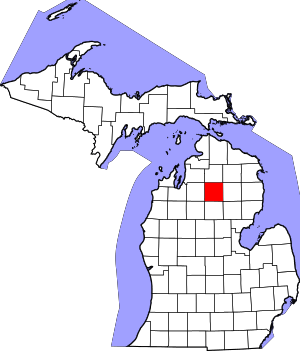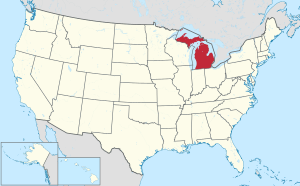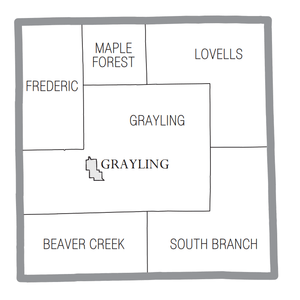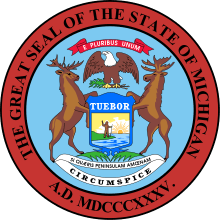Crawford County, Michigan
Crawford County is a county in the U.S. state of Michigan. As of the 2010 census, the population was 14,074.[2] The county seat is Grayling.[3]
Crawford County | |
|---|---|
.jpg) Crawford County Building in Grayling | |
 Location within the U.S. state of Michigan | |
 Michigan's location within the U.S. | |
| Coordinates: 44°41′N 84°37′W | |
| Country | |
| State | |
| Founded | 1840[1] |
| Named for | William Crawford |
| Seat | Grayling |
| Largest city | Grayling |
| Area | |
| • Total | 563 sq mi (1,460 km2) |
| • Land | 556 sq mi (1,440 km2) |
| • Water | 7.0 sq mi (18 km2) 1.2%% |
| Population | |
| • Estimate (2018) | 13,901 |
| • Density | 25/sq mi (10/km2) |
| Time zone | UTC−5 (Eastern) |
| • Summer (DST) | UTC−4 (EDT) |
| Congressional district | 1st |
| Website | www |
History

The county is named for Col. William Crawford,[5] a Revolutionary War soldier killed in 1782 while fighting Native Americans in Ohio. It was created by the Michigan Legislature in 1840 as Shawono County, then renamed Crawford County in 1843. The county was administered by a succession of other Michigan counties prior to the organization of county government in 1879.[4][1]
Geography
According to the U.S. Census Bureau, the county has a total area of 563 square miles (1,460 km2), of which 556 square miles (1,440 km2) is land and 7.0 square miles (18 km2) (1.2%) is water.[6] The county is part of Northern Michigan.
The County is part of the Au Sable State Forest, specifically the Grayling FMU (Alcona, Crawford, Oscoda, and northern Iosco counties). Glaciers shaped the area, creating a unique regional ecosystem. A large portion of the area is the so-called Grayling outwash plain, which consists of broad outwash plain including sandy ice-disintegration ridges; jack pine barrens, some white pine-red pine forest, and northern hardwood forest. Large lakes were created by glacial action.[7]
Adjacent counties
- Otsego County - north
- Montmorency County - northeast
- Oscoda County - east
- Ogemaw County - southeast
- Roscommon County - south
- Missaukee County - southwest
- Kalkaska County - west
- Antrim County - northwest
National protected area
- Huron National Forest (part)
Demographics
| Historical population | |||
|---|---|---|---|
| Census | Pop. | %± | |
| 1880 | 1,159 | — | |
| 1890 | 2,962 | 155.6% | |
| 1900 | 2,943 | −0.6% | |
| 1910 | 3,934 | 33.7% | |
| 1920 | 4,049 | 2.9% | |
| 1930 | 3,097 | −23.5% | |
| 1940 | 3,765 | 21.6% | |
| 1950 | 4,151 | 10.3% | |
| 1960 | 4,971 | 19.8% | |
| 1970 | 6,482 | 30.4% | |
| 1980 | 9,465 | 46.0% | |
| 1990 | 12,260 | 29.5% | |
| 2000 | 14,273 | 16.4% | |
| 2010 | 14,074 | −1.4% | |
| Est. 2018 | 13,901 | [8] | −1.2% |
| U.S. Decennial Census[9] 1790-1960[10] 1900-1990[11] 1990-2000[12] 2010-2018[2] | |||
As of the census[13] of 2000, there were 14,273 people, 5,625 households, and 4,038 families residing in the county. The population density was 26 people per square mile (10/km²). There were 10,042 housing units at an average density of 18 per square mile (7/km²). The racial makeup of the county was 96.38% White, 1.50% Black or African American, 0.60% Native American, 0.25% Asian, 0.02% Pacific Islander, 0.20% from other races, and 1.05% from two or more races. 0.99% of the population were Hispanic or Latino of any race. 24.8% were of German, 12.5% English, 10.1% American, 8.9% Irish, 7.4% Polish and 5.9% French ancestry. 97.7% spoke English and 1.5% Spanish as their first language.
There were 5,625 households out of which 30.00% had children under the age of 18 living with them, 57.60% were married couples living together, 9.70% had a female householder with no husband present, and 28.20% were non-families. 24.00% of all households were made up of individuals and 10.50% had someone living alone who was 65 years of age or older. The average household size was 2.45 and the average family size was 2.87.
In the county, the population was spread out with 24.50% under the age of 18, 6.30% from 18 to 24, 26.60% from 25 to 44, 26.00% from 45 to 64, and 16.60% who were 65 years of age or older. The median age was 41 years. For every 100 females there were 104.00 males. For every 100 females age 18 and over, there were 100.40 males.
The median income for a household in the county was $33,364, and the median income for a family was $37,056. Males had a median income of $31,504 versus $21,250 for females. The per capita income for the county was $16,903. About 10.00% of families and 12.70% of the population were below the poverty line, including 17.60% of those under age 18 and 7.60% of those age 65 or over.
Government
| Year | Republican | Democratic | Third Parties |
|---|---|---|---|
| 2016 | 63.6% 4,354 | 30.8% 2,110 | 5.6% 380 |
| 2012 | 55.0% 3,744 | 43.9% 2,994 | 1.1% 76 |
| 2008 | 49.6% 3,561 | 47.9% 3,441 | 2.5% 176 |
| 2004 | 55.5% 4,017 | 43.2% 3,126 | 1.3% 92 |
| 2000 | 52.6% 3,345 | 43.8% 2,790 | 3.6% 229 |
| 1996 | 37.7% 2,157 | 46.6% 2,666 | 15.7% 898 |
| 1992 | 37.0% 2,193 | 38.0% 2,252 | 25.0% 1,480 |
| 1988 | 62.3% 3,097 | 36.7% 1,825 | 1.0% 51 |
| 1984 | 67.5% 3,303 | 31.8% 1,558 | 0.7% 35 |
| 1980 | 53.4% 2,652 | 36.8% 1,826 | 9.8% 486 |
| 1976 | 54.8% 2,359 | 43.9% 1,889 | 1.3% 55 |
| 1972 | 62.0% 1,953 | 36.3% 1,143 | 1.8% 55 |
| 1968 | 55.0% 1,266 | 36.7% 845 | 8.2% 189 |
| 1964 | 32.2% 696 | 67.8% 1,464 | 0.0% 0 |
| 1960 | 65.0% 1,464 | 34.8% 783 | 0.2% 4 |
| 1956 | 71.5% 1,380 | 28.3% 547 | 0.2% 3 |
| 1952 | 72.5% 1,331 | 26.7% 490 | 0.8% 14 |
| 1948 | 63.9% 849 | 34.3% 455 | 1.8% 24 |
| 1944 | 58.8% 797 | 40.6% 550 | 0.6% 8 |
| 1940 | 52.5% 873 | 46.8% 777 | 0.7% 12 |
| 1936 | 38.9% 580 | 58.7% 876 | 2.5% 37 |
| 1932 | 41.8% 559 | 56.5% 755 | 1.7% 23 |
| 1928 | 76.3% 776 | 23.3% 237 | 0.4% 4 |
| 1924 | 72.9% 840 | 14.2% 163 | 12.9% 149 |
| 1920 | 64.4% 726 | 32.0% 361 | 3.6% 40 |
| 1916 | 46.2% 409 | 50.9% 450 | 2.9% 26 |
| 1912 | 35.0% 257 | 25.2% 185 | 39.9% 293[15] |
| 1908 | 67.8% 590 | 27.2% 237 | 4.9% 43 |
| 1904 | 73.6% 587 | 23.8% 190 | 2.6% 21 |
| 1900 | 62.6% 440 | 35.9% 252 | 1.6% 11 |
| 1896 | 49.7% 350 | 49.7% 350 | 0.7% 5 |
| 1892 | 48.6% 300 | 49.6% 306 | 1.8% 11 |
| 1888 | 47.1% 436 | 51.8% 479 | 1.1% 10 |
| 1884 | 56.7% 304 | 41.6% 223 | 1.7% 9 |
The county government operates the jail, maintains rural roads, operates the major local courts, keeps files of deeds and mortgages, maintains vital records, administers public health regulations, and participates with the state in the provision of welfare and other social services. The county board of commissioners controls the budget but has only limited authority to make laws or ordinances. In Michigan, most local government functions — police and fire, building and zoning, tax assessment, street maintenance, etc. — are the responsibility of individual cities and townships.
Elected officials
- Prosecuting Attorney: Sierra Koch
- Sheriff: Shawn M Kraycs
- County Clerk/Register of Deeds: Sandra M. Moore
- County Treasurer: Kate Wagner
(information as of June 2019l)
Communities

City
Charter township
Civil townships
Historical markers
There are six recognized Michigan historical markers in the county:[16]
- Beginning of State Reforestation
- Chief Shoppenagon / Shoppenagon's Homesite
- The Douglas House / Thomas E. Douglas
- Michigan Grayling
- Officer's Club
- 32nd Red Arrow Division
See also
- List of counties in Michigan
- List of Michigan State Historic Sites in Crawford County, Michigan
- National Register of Historic Places listings in Crawford County, Michigan
References
- "Bibliography on Crawford County". Clarke Historical Library, Central Michigan University. Retrieved 2016-11-04.
- "State & County QuickFacts". United States Census Bureau. Retrieved August 27, 2013.
- "Find a County". National Association of Counties. Archived from the original on May 31, 2011. Retrieved June 7, 2011.
- Newberry Library. "Michigan: Individual County Chronologies". Atlas of County Historical Boundaries. Retrieved 2016-11-04.
- Gannett, Henry (1905). The Origin of Certain Place Names in the United States. Govt. Print. Off. pp. 95.
- "2010 Census Gazetteer Files". United States Census Bureau. August 22, 2012. Archived from the original on November 13, 2013. Retrieved September 19, 2014.
- "NPWRC :: Regional Landscape". usgs.gov. Archived from the original on June 25, 2013.
- "Population and Housing Unit Estimates". Retrieved May 18, 2019.
- "U.S. Decennial Census". United States Census Bureau. Retrieved September 19, 2014.
- "Historical Census Browser". University of Virginia Library. Retrieved September 19, 2014.
- "Population of Counties by Decennial Census: 1900 to 1990". United States Census Bureau. Retrieved September 19, 2014.
- "Census 2000 PHC-T-4. Ranking Tables for Counties: 1990 and 2000" (PDF). United States Census Bureau. Retrieved September 19, 2014.
- "U.S. Census website". United States Census Bureau. Retrieved January 31, 2008.
- http://uselectionatlas.org/RESULTS
- The leading "other" candidate, Progressive Theodore Roosevelt, received 249 votes, while Socialist candidate Eugene Debs received 35 votes, Prohibition candidate Eugene Chafin received 8 votes, and Socialist Labor candidate Arthur Reimer received 1 vote.
- "Michigan Historical Markers". michmarkers.com. Archived from the original on 2010-03-15. Retrieved 2008-01-09.
